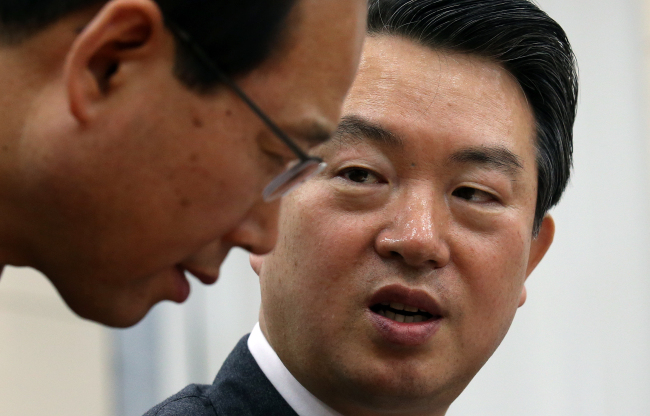In the aftermath of the antigovernment rally held more than a week ago in central Seoul, controversy is escalating over the use of water cannons and bus barricades by police, with rival parties scrambling to present bills to prevent violence at rallies.
The police and progressive civic groups have locked horns over who should be held accountable for the collapse of Baek Nam-gi, a 69-year-old farmer who was knocked down by a water cannon blast in the Nov. 14 rally and has remained unconscious as of Monday.
A local human rights watchdog group branded the use of water cannons as an “attack” against innocent civilians.
In a recent press briefing, the group claimed it witnessed the police setting up bus blockades and firing the water cannons even before the protest turned violent. As the police targeted the face and upper body of protestors, many sustained fractures and bleeding.
Citing the recent research, the civic group also pointed out that spraying the water mixed with tear gas on the human body may cause serious problems, including skin rashes, hives, irritation and temporary blindness.
In response, the police argued that it was inevitable to use the water cannons to stop protestors committing violence and did not plan to stop using the 19 water cannons to break up “violent” protestors.
“It is unfortunate that Baek sustained an injury, but it was a rare accident that took place while stopping violent protests,” the police said.
 |
| National Police Agency chief Kang Sin-myeong (right) attends a parliamentary meeting Monday on security and public administration. (Yonhap) |
The police also cited the data that shows a significant drop in the number of “violent” protests and injuries for police officers since it began employing the water cannons in 2005.
The number of rallies that spiraled into violence halved from 128 in the 1999-2005 period to 52 in the 2006-2014 period, with the number of police injuries also having decreased from 614 to 281 during the same period.
The police also defended the decision to set up bus barricades to shut down Gwanghwamun Square and bar protestors from marching toward the presidential office.
“The police bus barricades were not used to deter the protestors from marching, but they were employed to prevent occurrences of violence,” Kang Sin-myeong, the National Police Agency commissioner general, said at a parliamentary meeting held Monday.
“Protestors destroyed the police line and tried climbing up the buses, and they attempted to cross into the area they were banned from,” he said.
But opposition lawmaker Rep. Jin Seon-mi of the New Politics Alliance for Democracy slammed the police for overusing force, citing a ruling made by the Constitutional Court in 2009.
The 2009 ruling outlawed the use of police bus barricades, as they severely disrupt the free movement of the public.
The rival party lawmakers, meanwhile, each introduced revision bills for the Demonstration and Public Assembly Act, with the ruling Saenuri Party defining the rally as a “violent protest,” while the NPAD accused the police of cracking down on the public’s freedom of speech.
Rep. Jin of the opposition party, along with 16 other lawmakers, presented a bill banning the police bus barricades.
“The police are abusing their power to set up police barricades with buses, as there are no clear rules stipulating the use of the barricade. The bill will guarantee the public freedom of holding public assemblies by barring the police from stopping them with the police buses,” she said.
Rep. Jung Gap-yoon of the ruling party, meanwhile, plans to submit a revision Tuesday that forbids protestors from covering their faces with masks.
Meanwhile, the KCTU, the nation’s second-largest umbrella union group that led the Nov. 14 rally, hinted at another mass rally in central Seoul on Dec. 5.
Accusing the government of steering public opinion against the labor union to dodge responsibility for the deadly crackdown, it vowed an all-out war against the oppressive government in a press briefing held near Cheong Wa Dae.
“We are determined to defy the crackdown and maintain our posture to fight against the government’s plan for labor market reform,” the press release read.
By Ock Hyun-ju (laeticia.ock@heraldcorp.com)

